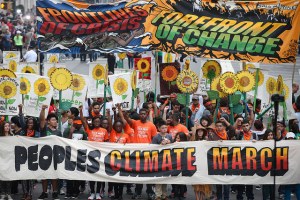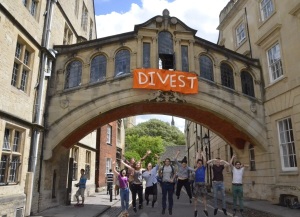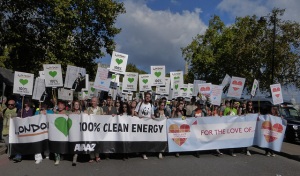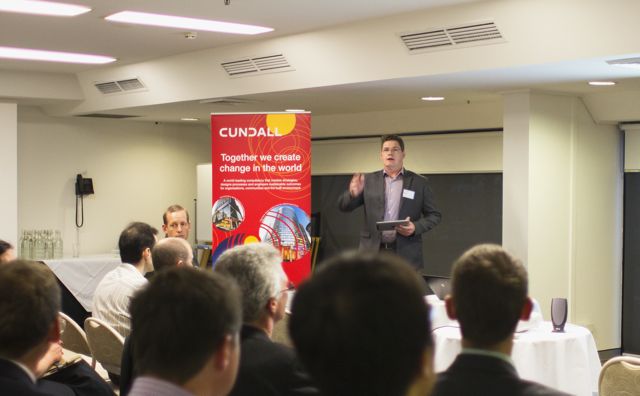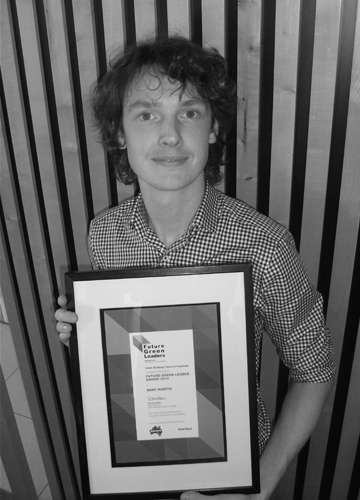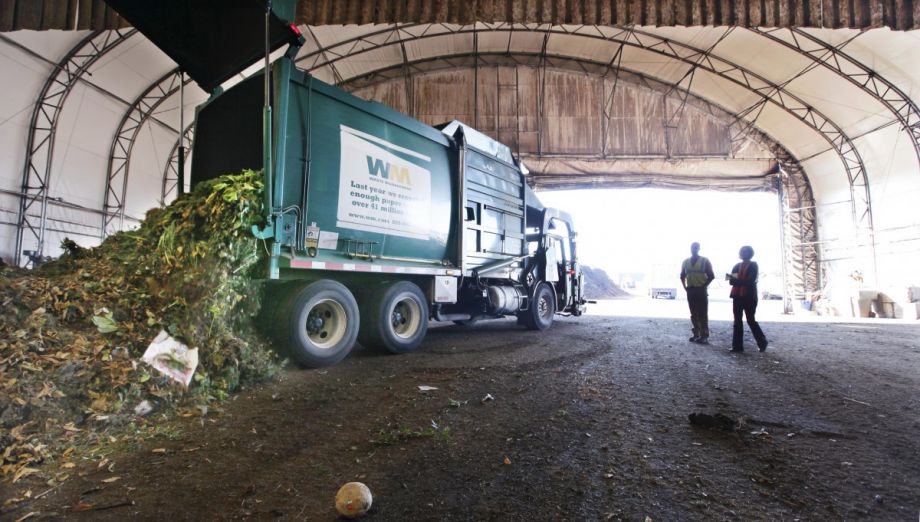 |
| 2 Varroa mites on a drone of the western honey bee (Wikipedia) |
by ABC.net.au Catalyst:
http://www.abc.net.au/catalyst/stories/4094061.htm
The world is experiencing a global bee crisis, and with bees
responsible for almost a third of the food on our plate, this is a
crisis that could affect us all.
In the winter of 2013, areas of Europe
lost up to 53% of its bee population. Similar declines have been
recorded in the US.
Astonishingly, Australia is the only country in the
world where the bee population continues to thrive.
As commercial
beekeepers are pushed out of business abroad, Australian bees are
exported to pollinate foreign farmlands. However, the fate of Australian
bees hangs in the balance. It seems that the bee crisis is intricately
tied to the way we have changed our planet.
Catalyst investigates how
modern agriculture methods, increasing diseases and the impending threat
of the deadly varroa mite could destroy the last safe-haven for bees on
the planet.
TRANSCRIPT
NARRATION: There's one animal on the planet that can make or break our food supply. Even the shape of our food depends on it.
John Evans: Well, there's five sectors in an apple, if they're not pollinated evenly, then you don't get a perfectly round apple.
NARRATION: We rely on bees to pollinate most of our food crops, and one species in particular.
Mark Horstman: Of
about 1,500 species of bees that live in Australia, this is the most
recognisable and the one we take most for granted - the European honey
bee. First introduced nearly 200 years ago, they've been here long
enough to be considered practically native.
NARRATION: But
elsewhere, the honey bee world is in dire peril. Each year for the last
decade, about a third of their colonies have died. It's a mystery known
as colony collapse disorder - a perfect storm of pesticides, habitat
loss, diseases and a vampire parasite called varroa.
Dr Stephen Quarrell: It's multiple effects - it's not just pesticides and it's not just varroa.
NARRATION: This
is a story from the front line - farmers, beekeepers, scientists and
honey lovers determined to secure a future for bees and for us. When it
comes to honey bees, Australia really is the lucky country. We're the
last safe haven because the varroa mite isn't here yet.
Peter Norris: Yeah, the only continent in the world that hasn't got it.
Mark Horstman: Well, that's incredible.
Peter Norris: Yeah.
Mark Horstman: Is that just luck, or good management?
Peter Norris: Luck.
NARRATION: At
a cost of only a couple of hundred thousand dollars each year, hives
like these stand guard around our major ports to detect invasions of
exotic bees and pests. Leatherwood honey producer
Peter Norris manages the sentinel hives in Hobart. He dreads an invasion by varroa.
Peter Norris: We don't want it here. We should do everything we can to keep it out.
NARRATION: Varroa
is a genus of mites that suck the blood of bees and their larvae,
spreading viral diseases. Compared to the size of its host, varroa is
one of the largest parasites on the planet. This worker bee in the UK
has a mite attached. You can see how agitated the bee is, which prevents
it doing the jobs that keep a hive healthy. Peter has seen the varroa
invasion before.
Peter Norris: Well, I've had
some experience. I was in the UK when they discovered it there. I'd been
keeping bees for quite a few years there, got out to about 150 hives,
and the year that they discovered varroa, I went down to 25. We lost 80%
of the bees in the south-east of England.
Mark Horstman: In a year?
Peter Norris: In that one season, yeah.
Mark Horstman: What would you expect to see if you had varroa in this hive?
Peter Norris: You
would see adult bees with very deformed abdomens, deformed wings, not
capable of flight. Because of that, the food supplies in the hive
diminish very rapidly.
NARRATION: That
devastating prospect could be entering a port right now. Department of
Agriculture officers board ships to search for foreign insects,
particularly Asian honey bees - the natural host of varroa mites.
Ross Rickard: A
ship could be docked in an overseas port and the swarm will come and,
just by accident, land on a ship or some cargo, and they will usually
hide under a container or under beams. Not every ship is inspected, but
there's risk profiling that's done on different ships.
Mark Horstman: It
just takes one bee in one container in one ship in any port for varroa
mite to arrive in Australia, and that's the challenge for Australian
biosecurity - to stop that stowaway bee escaping in the first place.
NARRATION: Foreign
swarms are found and destroyed up to a dozen times a year. In 2011, a
swarm of Asian honey bees brought their own unwelcome passengers.
Ross Rickard: We discovered the swarm had more than 150 varroa mites associated with it.
Mark Horstman: So a good one to spot.
Ross Rickard: It was really important because if it had have absconded, then the varroa mites could have got away.
NARRATION: However,
we actually import queen bees from varroa-infected countries in the
hope of breeding their genetic defences into our bees.
Ross Rickard: If
we ever do get varroa, hopefully some of the queens that are now being
imported will have resistance to varroa so we'll be one step ahead in
the battle against this dreadful parasite.
NARRATION: Ross
Rickard runs three months of quarantine checks on each import to ensure
that not only are the bees clean, but their packaging as well. It's not
without risk, and for safety's sake, the bees that arrive here never
leave the lab. The queen spends the rest of her days laying eggs in a
secure hive. Varroa mites don't just suck blood - they use the hive to
lay their own eggs.
Ross Rickard: When the queen starts laying eggs, we examine that brood and make sure that there's no mites in there.
NARRATION: Beekeepers
can dose their hives with chemicals to control varroa, but wild, or
feral, bees don't get that help. These bees have left the hive to strike
out on their own. Unlike the rest of the world, Australia is still an
easy place for honey bees to survive in the wild.
Peter Norris: There's a lot more feral colonies in any environment than most people realise.
NARRATION: That's not the case in countries with varroa, where honey bees can only thrive in managed hives.
Mark Horstman: This
is what makes Australia paradise for the honey bees. Wild hives like
this one. Our pollination depends on it. But if the varroa mite should
ever invade Australia, wild hives like this will be the first to die.
Tiffane Bates: So
they would collapse first, and by collapsing, the varroa mite
populations will then descend on the commercial populations and the
management becomes more difficult.
NARRATION: Queen bee breeder
Tiffane Bates manages the research hives at the University of WA.
Tiffane Bates: For
bees, the varroa mite is the big scary. And once that arrives here,
we'll have about three to five years before the massive collapse of
potentially commercial beekeeping. They can feed themselves pretty well,
but...
NARRATION: The question is, can we
breed a commercial bee population in Australia that's resistant to
varroa mite? Today male drones from the uni bee yard end up in the lab
as sperm donors.
Professor Boris Baer: So ... here comes the sperm.
NARRATION: Each
male has this elaborate apparatus for docking with the queen in flight.
Known as a suicidal mater, he blasts a sperm package and his penis into
the queen - an ejaculation so violent it kills him. Undaunted, males
take flight every afternoon to search for a queen by following her
scent. To collect drones in the area, Tiffane baits the net with just a
tiny amount of queen pheromone.
Mark Horstman: It's
enough to have drones feeding on all the trees around here and probably
the bee farm just over there flocking in. It doesn't take them very
long at all. It's a remarkable demonstration of not only their ability
to sense incredibly well, but to navigate really keenly.
Tiffane Bates: So, in theory, unless it's only our males, there should be a bit of a mixture in there.
NARRATION: In
Australia, we're still fortunate to have plenty of healthy wild bees
mating with hive bees, so there's constant genetic exchange. Amazingly,
after mating with up to 15 males in a flight, the queen somehow selects
the sperm she wants to keep. This tiny organ, called the spermatheca,
holds the future of the entire colony. With it, the queen fertilises up
to 2,000 eggs a day for the rest of her life, choosing from the sperm
stored inside.
Professor Boris Baer: One of the questions is, of course, what does she want? And I don't yet know what she wants.
NARRATION: While the male dies after only three weeks, his sperm lives on in the queen for another seven years.
Professor Boris Baer: It's easier in the spring.
NARRATION: Boris Baer is artificially inseminating virgin queens to find out how they do it.
Professor Boris Baer: The
secret of long-term sperm storage can be compared to the fountain of
youth. The female provides a major liquid and that does it - a single
substance that we think is responsible to kind of turn sperm on, like,
really, poof!
Mark Horstman: And the sperm
itself triggers changes in the queen's brain that enable her to control
the hive. Unravelling how the queen manages the genetic diversity of the
colony is crucial to understanding how bees can resist varroa. For
example, worker bees help clear the hive of parasites and diseases by
removing dead or diseased individuals. This hygienic behaviour is
inherited, and bees that are good at it have a better chance of standing
up to varroa.
Dr Mathew Welch: See, if we can
select for these traits, in particular, hygienic behaviour and things
like that, then we can try and breed bees that are more resistant. But
at the same time, we need to really be careful that we don't breed out
the genetic diversity that's present in bees.
NARRATION: Molecular
biologist Matt Welch is delving deep into the honey bee genome to
explore the interplay between brains, genes and reproduction. He studies
the biochemical reactions that switch different genes on and off. This
process, called epigenetics, doesn't change the actual DNA code but how
genes are expressed. To extract DNA from queen bees, you need fresh
brains.
Dr Mathew Welch: So queens have a much
smaller brain than workers because the workers have a lot more sensory
information to process. This is the part that we're really interested
in, this central portion of the brain.
NARRATION: No
larger than the head of a pin, it could hold the key to switching on a
defence against varroa. To find that key, powerful next-generation
sequences can rapidly read billions of genes from honey bee DNA.
Dr Mathew Welch: So this has really unlocked our ability to do whole genome studies and to really explore genetic regulation and gene expression.
NARRATION: Varroa
mites were able to jump from their Asian host to European honey bees by
recognising their chemical messages as signals to lay eggs in their
hives. It just might be a chink in the mite's armour.
Dr Mathew Welch: If
we can find a way to mask or block either the receptor that detects
that signal or even the genes that encode that signal in honey bees, we
could potentially make the European honey bee invisible to varroa mites
again, effectively eliminating their reproductive cycle.
Mark Horstman: Like a vaccine.
Dr Mathew Welch: Yeah, that's right.
NARRATION: That
prospect, where honey bees escape varroa's life cycle, is an exciting
one. But in the meantime, there are some other more fundamental
mysteries to solve.
Mark Horstman: Swarms of
bees operate in a vast volume of time and space. But nobody really knows
where they go. Now, for the first time, miniaturised technology offers
the opportunity to monitor their environment from a bee's point of view.
Paulo de Souza: We give each one of those bees a badge and we follow them. We give each one of those bees a number.
NARRATION: Physicist,
Paulo de Souza is working with entomologist Steve Quarrell to attach
tiny sensors to the backs of middle-aged worker bees.
Dr Stephen Quarrell: We're
trying to get bees that are right on the edge of starting to fly but
we're trying to get the full flight duration of the bee, so two to three
weeks. The hairier they are, the younger they are. So we're after,
well, bald bees, almost (chuckles).
NARRATION: The
tags on the bees are like PayPass on your credit card - a reader at the
entry to the hive clocks them in and out. It's fiddly, painstaking
work.
Dr Stephen Quarrell: Next spring, when we do the full experiment, it'll be about 50 bees per hive per day over a four- or five-week period.
Mark Horstman: So in total, at the end of the project?
Dr Stephen Quarrell: About 5,000.
NARRATION: Their
first experiment will see if neonicotinoid pesticides have any impact
on the bees' activity. These chemicals have been banned in Europe for
two years because of concerns they affect bees' navigation, reproduction
and immune responses.
Dr Stephen Quarrell: So,
normally benign viruses and diseases or mites, so varroa mite, are
having a greater impact in the hive than was previously thought
basically due to these trace quantities of pesticide.
NARRATION: They
plan to put traces of pesticide in feeder stations with tag readers to
detect any changes in flight time and feeding behaviour. But the swarm
sensing should also be able to tell if pests start turning up.
Paulo de Souza: So
we know if a new species arriving would drive any changes in the hive,
would drive any changes in the ecosystem, and how that will affect our
industry, we can transform the way we do biosecurity, and this is what
we want to achieve.
NARRATION:
John Evans is hosting the research on his apple orchard. He hopes to use the information to position his hives for the best pollination.
John Evans: There's
thing about bees that we don't know. I don't think we probably spend
enough time in understanding where bees are and what they do, because
they're so beneficial to us - there goes one now.
NARRATION: The same is true for urban environments.
Doug Purdie keeps high-rise hives in Sydney.
Doug Purdie: I
think having beehives in the city is immensely valuable. Clearly, we
don't have a lot of pollinators in the city areas. Because of our fear,
we tend to remove them. So putting backyard beehives in has gotta be a
good thing.
Mark Horstman: If people are wondering what they can do personally to help the bees, what would you recommend?
Doug Purdie: Look,
it's easy for people to help bees. If you look at what we're planting
in the gardens, people love grass and things that don't flower. But all
they have to do is start planting things that flower 'cause flowers are
what bees need. If you've got flowering things, bees will come.
Mark Horstman: If
we want to keep taking advantage of all the benefits that bees offer,
then it's only fair that we provide good food, shelter and health care
in return because, in the end, if it's good for bees, it's good for us.
Tiffane Bates: There's
something about the sound of bees on a summer afternoon that's just
deep contentment. And I think that that's why I'm here. Apart from all
the bees are amazing and pollination and all of those things, I'm in it
because when it works, it works with absolute perfection.
- Reporter: Mark Horstman
- Producer: Mark Horstman
- Researcher: Claire Smith
- Camera: Mike Kleim
David Hudspeth
Armin Azad
ADDITIONAL CAMERA:
Aerial Inspections
- Sound: Tim Parratt
David Fraser
Alex Tscholakoff
- Editor: Vaughan Smith
Centre for Integrative Bee Research, UWA
The Urban Beehive, Sydney
Department of Agriculture – bee pests and diseases
CSIRO – microsensors and swarm-sensing
Entomologist Prof Marla Spivak on why bees are disppearing
National Beekeeping Centre Wales
Senate report - Future of the beekeeping and pollination service industries in Australia, July 2014
Ross Rickard
Entomologist
Dept of Agriculture, Sydney
Tiffane Bates
Centre for Integrated Bee Research, UWA
Prof Boris Baer
Centre for Integrated Bee Research, UWA
Dr Mathew Welch
Centre for Integrated Bee Research, UWA
Prof Paulo De Souza
Science Leader, CSIRO
Dr Stephen Quarrell
UTAS/Tas Institute of Agriculture
John Evans
Apple orchardist, Geeveston Tas
Doug Purdie
Apiarist, The Urban Beehive
Peter Norris
Apiarist, Southern Tasmanian Beekeepers Assoc

